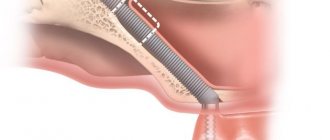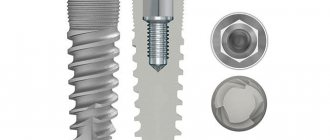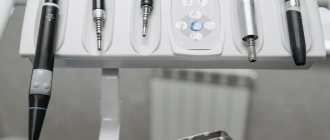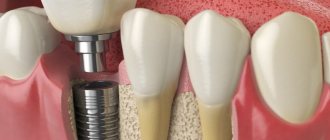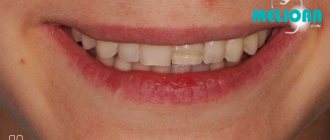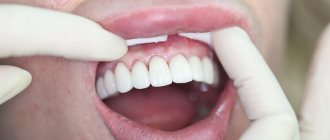Implantation of teeth in the upper jaw has its own specifics: first of all, it is associated with the structural features of bone tissue. Its density is somewhat lower, since during the chewing process the upper jaw undergoes less stress. This leads to the fact that after tooth loss, atrophy of looser bone tissue develops faster. That is why, according to statistics, preliminary osteoplastic surgery is required precisely when installing dental implants in the upper jaw. In addition, a longer healing period is a feature - on average, it takes 1-2 months more than for lower jaw implants.
The second feature is the close location of the maxillary sinuses. If the height of the bone near the canines and lateral incisors is not enough, a sinus lift is mandatory - an operation to raise the bottom of the sinuses. The proximity of the infraorbital foramen and the nerve requires special care and requires even greater professionalism from the dentist.
And finally, an important feature is aesthetics - the front teeth of the upper jaw, with a correct bite, form the overall impression of a smile, so the appearance of the implants and gums should be as natural and attractive as possible.
Indications and contraindications for installing implants in the upper jaw
Main indications:
- partial or complete edentia;
- aesthetic defects resulting from the destruction of crowns.
Contraindications are conditional (include health problems for which the procedure is prohibited, implantation is possible after their exclusion) and absolute (implantation is contraindicated).
Absolute contraindications:
- chronic teeth grinding;
- increased tone of the masticatory muscles;
- blood clotting disorder;
- diseases of the central nervous system;
- pathologies of the heart and blood vessels;
- dysfunction of the endocrine system.
Relative contraindications:
- inflammatory processes of the oral cavity;
- thinning of the bone structures of the jaw;
- pregnancy and breastfeeding period.
What are the complications of implantation in the upper jaw?
The procedure for implanting upper teeth is more difficult than lower teeth due to the softer structure of the maxillary bone. Restoration of lost units from above is carried out with elongated models of titanium roots:
- in areas near the maxillary sinus;
- into pre-grown bone mass;
- after a sinus lift (increasing the volume of lost bone by raising the maxillary sinus and filling the resulting space with biomaterial).
Implantation in the lower jaw is carried out with the expectation of eliminating damage to the trigeminal nerve . To do this, a computed tomography scan is first performed, which allows you to accurately determine its passage. If there is insufficient bone volume, it is also restored using bone grafting.
Prices
| Service | Price |
| Implant Astra Tech (Sweden) | from 57,000 rub. |
| Bicon implant (USA) | from 45,000 rub. |
| Implant MIS (Israel) | from 30,000 rub. |
| Osstem implant (South Korea) | from 19600 rub. |
| SLA implant (Switzerland) | from 63,000 rub. |
| Super Line implant (South Korea) | from 37,000 rub. |
| Nobel implant (USA) | from 50,000 rub. |
| Implant Straumann (Switzerland) | from 45,000 rub. |
To avoid possible misunderstandings, please clarify the cost of services in clinics with the administrator or during a consultation with a doctor. Prices on the website are not a public offer.
Sign up for a consultation
It is thanks to chewing teeth that people can chew food. In their absence, digestive problems will quickly make themselves felt. In addition, the bite may change, the oval of the face may change, and the jaw may begin to bend. Therefore, it is extremely important to undergo implantation of the 6th tooth in the lower jaw.
Features of implants for chewing and anterior teeth
Implantation of chewing teeth is carried out taking into account the increased chewing load on them. The artificial root is selected individually. However, when restoring lateral units, it should not be short and thin.
Implants are produced:
- lamellar (used in case of bone atrophy);
- root-shaped (implanted into bone tissue of sufficient volume);
- combined.
According to the type of construction for molars, the most reliable titanium rods are of the following types:
- endosseous (intraosseous);
- subperiosteal (implanted into the alveolar process);
- intramucosal (part of a removable denture);
- endodontically stabilized (extend the root system by 7 and 8 units).
Implantation of frontal units involves focusing on the aesthetic result, since the incisors are practically not involved in the chewing process. Therefore, the strength requirements for implants are not so high. They are selected taking into account the following characteristics:
- Maximum biocompatibility of the material with jaw structures.
- The length should be within 10 mm.
- Small diameter. This indicator ensures the implantation of the rod with minimal damage to nearby tissues, which is also significant for the aesthetic result.
Expert opinion
Vladimir Aleksandrovich Voznyuk
maxillofacial surgeon, implantologist
Experience: more than 33 years
In whatever area of the upper jaw a “gap” is formed - frontal, lateral or chewing - a negative impact on the body is inevitable. The fact that the absence of a tooth is not noticeable from the outside is not an argument in favor of refusing restoration. Decreased quality of chewing function, malocclusion, increased load on neighboring teeth, and as a result - their rapid destruction - these are just some of the problems that will become obvious in the near future. Implantation of teeth in the upper jaw will stop bone atrophy, ensure normal chewing and consumption of any usual food, and prevent early aging of the face. When planning implantation, it is important to choose a reliable clinic and specialist who will individualize the approach to the problem and propose a protocol that is optimal for you.
Options for setting teeth up
Implantation of the upper dental row is carried out in two ways - one-stage and two-stage. Recently, dentists are more often choosing the first technique due to the immediate aesthetic result, especially when restoring anterior units. However, the express method is more risky in terms of tissue infection and has a greater number of contraindications compared to the classical one.
Classic technique with delayed loading
The two-stage implantation method includes:
- Implantation of an artificial root into the gum.
- Fixation of the crown after 2-5 months.
Before the procedure, the patient undergoes:
- sanitation of the oral cavity for inflammation;
- general examination to identify contraindications;
- consultation with an otorhinolaryngologist (for restoration of teeth in the upper jaw);
- X-ray examination of the maxillofacial apparatus and orthopantomogram.
Next comes the most important moment - the implantation of a titanium rod. The operation is performed under local anesthesia in the following sequence:
- An incision in the gum and detachment of the mucous membrane.
- Preparing a place in the bone for the implant by drilling.
- Threading (unless it is a model with self-tapping threads).
- Screwing in the titanium root.
- Stitching.
Once the healing process is complete, an abutment is attached to the implant and a crown is placed.
The duration of the process of osseointegration of the rod with tissues ranges from two to five months.
One-step installation with immediate loading
It is carried out quickly with an immediate load on the artificial root. Often used after tooth extraction. The specialist’s action plan is as follows:
- Introduction of anesthesia.
- Unit extraction.
- Preparing the bed for the implant.
- Installation of the rod.
- Installation of a temporary crown.
After the end of the osseointegration period, the temporary crown is removed and a permanent one is placed.
Affordable dental implantation: how to quickly find a new tooth to replace a lost one
Patients are especially concerned about problems with their front teeth.
This is not only physical discomfort, but also problems with communication and self-esteem. Modern techniques allow you to maintain the aesthetics of your appearance. The main thing is to make the right decision in time. Clinic dentists fight for every natural unit, preserving it using affordable methods. But when the root is too damaged and it is impossible to restore it, the patient is offered removal. If the tissues are healthy and the bone has the required height and density, then immediate implantation is proposed. This step is psychologically comfortable for the patient and brings a minimum of unpleasant sensations.
The advantage of this method is that if you lose a non-viable tooth, you can immediately get a new artificial one. There is only one surgical intervention, there is also only one anesthesia, but two operations are performed at once: the destroyed root is removed and simultaneous dental implantation is performed. Our surgeons are highly qualified and perform manipulations flawlessly.
The tooth is removed, an artificial implant is placed in the same hole, and the gum is sutured. If there are no external circumstances, then a temporary plastic crown is installed on the pin. This is especially important when you have to work with the smile area. For the upper front teeth, special models of implants are used - with a relatively small diameter and a special specific thread.
Why is it necessary to build up bone tissue and do a sinus lift?
Often with edentia there is a lack of bone mass. The longer the space in the jaw is empty without proper load, the more active the atrophic processes are. Volume can be restored through bone grafting. This is an effective procedure aimed at creating a reliable foundation for a titanium rod. It is indicated for:
- bone atrophy;
- loss of tissue due to periodontitis (inflammatory process of the structures that support the tooth);
- deterioration of bone condition after injury.
More often the problem occurs in the upper jaw. This is due to the peculiarities of the anatomical structure. A significant part of the bone in the upper row is the maxillary sinus. The sinus lift technique allows you to restore the missing volume. The procedure is carried out if:
- bone structures have decreased in the area of the alveolar process;
- there is a loss of thickness due to the anatomy of the jaw.
Why implantation and not a bridge or removable denture?
- A dental bridge
is only suitable for included defects with a total length of no more than 4 teeth. The main disadvantage is that it requires grinding down two adjacent teeth for support. Sometimes these are completely healthy teeth that have to be covered with crowns. Service life 7-9 years. Does not prevent bone tissue atrophy. - A removable denture
is secured to crowns or natural teeth using special hooks. Most often, structures are made with support on an artificial palate, which makes them very uncomfortable to wear, can change diction, and provoke increased salivation and nausea. Fixation hooks put pressure on the tooth tissue, causing discomfort. Service life 3-5 years. Does not prevent bone tissue atrophy. - A bridge on implants
does not destroy other teeth, distributes the load evenly and is an excellent prevention of bone atrophy. It will cost more, but it will feel and look like your own teeth. It is not a source of discomfort, light and neat. Allows 100% restoration of the chewing function of the lateral parts of the jaw.
How many implants can and should be placed with complete edentia?
Implantation of the maximum number of units
The technique involves implanting an implant in place of each missing tooth (14 titanium roots on top and bottom). Then a crown is placed on each one. Only the eights, and sometimes the second molars, are excluded from the restoration process. In the latter case, 12 rods are installed. Implementation of the technology in conditions of complete edentia is possible only if the required volume of bone mass is available.
When an inserted prosthesis is attached to a minimum number of supports
If it is impossible to implant at least four implants, implantation is carried out on two or three units. Due to the subsequent attachment of abutments with a spherical tip, the prosthesis can be removed during hygiene procedures.
The second method of fixation is beam , which ensures correct distribution of the load during chewing of food and is slightly superior in reliability to spherical. An orthopedic structure secured in this way is also easily removable.
The prosthesis for spherical fastening in the design has rounded cavities corresponding to the outline of the abutments, and with beam fastening, the opposite part has the appearance of a dissected pipe.
Installation of a bridge on 4 or 6 artificial roots
All-on-4 ” and “ All-on-6 dental implant concepts are the best solution to the problems of complete edentia. They are used for:
- bone atrophy;
- close location of the maxillary sinus and the mandibular nerve.
The technology involves the implantation of four or six implants from above and below. The first ones are placed in place of the frontal units, the rest - at a certain interval. The latter are screwed into the jaws at an angle of 45⁰. The final stage is the installation of a removable or non-removable structure.
- Complete restoration of the dentition in just 4 days!
more detailsRoott Pterygoid Implants Sinus lift is no longer needed!
more details
Once and for life! Express implantation in 4 days with a permanent ReSmile prosthesis
more details
All-on-4, All-on-6, ReSmile, Zygomatic implantation We use all modern methods of dentition restoration
more details
How to choose a protocol
| Clinical case | Solution |
| Single or scattered defects | A classic (two-step protocol) is used. First, an implant is implanted, and a gum former is installed in its healing field. After 1-2 weeks, the crowns are fixed. If there is insufficient bone, surgery is performed to augment bone tissue before or simultaneously with implantation. |
| Missing row segment | The classical method is mainly used. In some situations, zygomatic implantation is possible, in which elongated implants are used. They are fixed into the zygomatic bone at an angle. Prosthetics are performed on 2-3 days. Osteoplasty is not needed. |
| Missing all teeth | More often, one-stage protocols are used without bone tissue augmentation. The prosthesis is installed immediately after implantation or on the 3rd day. The number and type of implants are selected based on the degree of bone atrophy and the condition of periodontal tissue. |
How much will it cost on average in Moscow?
The cost of implantation in different clinics is determined individually, taking into account:
- volume of planned work;
- materials used, medications;
- diagnostic procedures;
- the patient's wishes regarding aesthetics.
Let's give the average cost of dental implantation services in Moscow clinics.
| Name of service | Cost, rub. |
| Temporary crown | 4000 |
| Installation of the healing abutment | 5000 |
| Custom abutment | 7500 |
| Implantation, without implant cost | 22000 |
| Removable denture locator | 25000 |
| Turnkey implantation of one tooth using a two-stage method | |
| With metal-ceramic crown | 39100 |
| With all-ceramic crown | 50200 |
| Express implantation with metal-ceramic crown | 58000 |
| With a ceramic crown on a special alloy | 60000 |
| Full dental implantation for edentulous jaws | |
| Prosthetics on 4 implants according to the “All-on-4” protocol | 350000 |
| Prosthetics on 6 implants according to the “All-on-6” protocol | 450000 |
| Installation of 14 implants on the jaw, with bone grafting and prosthetics | 900000 |
Alternative Methods
Removable dentures Recommended if there are absolute contraindications to implantation or if there is a limited budget
Bridges Crowns rest on your own teeth on both sides. Suitable for restoring one or more teeth in a row
Clasp dentures A plastic frame on a durable metal arch, simulating gum, with tooth crowns inserted into it
Article Expert
Voznyuk Vladimir Aleksandrovich Implant surgeon, doctor of the highest category
Work experience: more than 35 years


